

Home | Call for Papers | Submissions | Journal Info | Links |
Journal of the Slovene Association of LSP Teachers
ISSN: 1854-
Yong Chen
Material Production for an EST Course: Coursebook Design for the English Training Programme for Architects and Civil Engineers
ABSTRACT
This paper presents the material production of an EST (English for Science and Technology) course in an English training programme for architects and civil engineers. The programme was specially designed for the construction professionals whose needs were investigated and analysed by the trainers, ESP (English for Specific Purposes) specialists from the British Council and Chinese counterparts. The article firstly focuses on the theories of needs analysis which support the investigation and analysis of the programme. After that, the needs of this programme (for both organization and participants) are recognized and organized with illustration of programme framework and a particular course (EST) syllabus. Then the literature of material design is reviewed and the rationale for the material writing is discussed with the presentation of a sample unit.
Key Words: needs analysis, material production, programme framework, rationale, task, EST, ESP.
1. Introduction
With the fast development of economy and technology in China, the demand for English
application has been growing in all the professional areas. Many professionals need
to read, write and speak English at their jobs to communicate with their work partners
or to obtain information in English. As a result, various English training programmes
have been developed to meet these needs in organizational settings, at tertiary level
education or in language training classes/schools. As a part of Technical Cooperation
Programme, the British Council and the Foreign Language School of Chongqing University
co-
2. Needs Analysis
In this section, literature on needs analysis will be reviewed first. Based on the study, the needs of target audience group will be investigated and identified as their business processes and communication needs in English.
2.1. Literature Research
As ESP is an approach to language teaching in which all decisions as to content and method are based on the learner’s reason for learning (Hutchinson and Waters, 1987:19), ESP programme designers should put a great weight on learners’ needs even though these needs are perceived by course designers as in EAP (English for Academic Purposes) at tertiary level education or surveyed and analysed as in EOP (English for Occupational Purposes) in any professional application. Mackay and Mountford (1978:21) also stated that “in order to design and teach effective courses, the teacher and planner must investigate the uses to which the language will be put”. After adequate investigation into learners’ needs, “the teacher is one step nearer being able to translate these needs into linguistic and pedagogic terms in order to produce and teach an effective course” (Mackay and Mountford, 1978:21). Therefore, it can be conceived that the needs analysis is an initial and allimportant step to ESP programme. Holliday (1995) presented the scope and approach of an ESP course as needs analysis, curriculum design and implementation design, where needs analysis came first.
It is known that ESP is distinguished from General English not in the existence of
needs as such but in the awareness of the needs (Hutchinson & Waters, 1987: 53).
So it is vital for programme developers to find learners’ needs and analyse them
in the view of not only teachers, but also course designers. According to Hutchinson
& Waters (1987: 55-
2.2. The Target Audience Group and Their Needs
The main participants of the course were post-
2.2.1. Why is English needed for the Learners’ Profession?
Since China became committed to reformation and opening up, the building and construction sector has been facing up to fresh challenges. One of the solutions to meet the challenge is to provide courses to enable architects to get National and International Accreditation, which requires their English language competence. The other is to consider setting up agencies abroad and sending architects abroad for training, construction projects or international conferences or other forms of exchanges/communication. In fact, some of the design institutes and construction companies have begun to tender internationally for projects. Therefore, English, as a lingua franca, is needed when they are entering the world market.
2.2.2. The Architects and Their Business Process
There are different kinds of architects and engineers working on the design of certain
projects. These include architects, structural engineers, service engineers (water,
gas, electricity supply, heating, ventilation and air-
Their design or work processes mainly involve the following stages:
· site analysis and planning
· cost analysis, design and construction planning
· design procedures
· structural engineering
· environmental control and services
· construction and material cost
· project management
2.2.3. The Basic Communicative Needs:
From the above described work processes, three broad communicative areas were ascertained that require coverage in the provision of any technical language training in construction field:
· Design/Technical
i.e. working drawings and related design literature e.g. case studies, codes, specifications and regulations
· Contractual/Business
i.e. the contract administration literature and the language of meetings, negotiations, etc.
· Product/Commercial & Technical
i.e. product information, e.g. product descriptions for CAD software, HVAC units, lift/elevator technology, etc.
These in turn require the architects and engineers to be able to:
· describe site plans, sketches, outline proposals and working drawings (plans, elevations, axonometrics, isometric detailing, etc.
· answer and ask questions related to all the above
· discuss design concepts and matters of architectural style
· present design work and understand the intention of other specialists' critical comments and react appropriately
· understand authentic articles and texts related to codes, modern trends, techniques, standards and performance specifications
· understand materials related to bids, tenders, contracts and project management practices
· take an effective part in technical/business type meetings and negotiations, etc.
These learners’ communicative needs will then be integrated into the following curriculum design and syllabus writing.
3. Course Outline
Based on the above needs analysis, the course designer identified the global aims of this course as: to enhance the participants' listening, speaking, reading and writing skills in general English; to bridge the gap between general English and common core technical English; to introduce linguistic element input along with specialist subject input and to activate learners' interests, awareness, confidence, autonomy and exploitability in learning by employing communicative classroom activities (Chen, 2005). Thereby, the programme framework was developed and EST course syllabus was devised.
3.1. The Programme Framework
The programme framework was devised with three stages -
In the framework, EST was one of the project courses at the third stage. According to the communicative needs of the target group, the destination goal for the learners was to apply language skills in the job communication. Thus, the ESP programme was designed to develop the participants' integrated skills, involving speaking, listening, technical reading, EST, commercial English and practical writing in three stages: preparatory, core course/intermediate and project course/upper intermediate.
3.2. EST Course
EST course focuses on practical projects, authentic material packages from case studies and working details. Text 2 in Unit One is presented as a sample text to demonstrate the material writing principles (See Appendix 2).
The rationale and theoretical basis of ESP material production will be studied in the following section with discussion on a sample text and the activities or tasks.
4. Rationale for the Material Production
There are three possible ways of material application: existing materials, materials
writing and materials adaptation (Hutchinson and Waters, 1987: 96). At the second
stage, Core Course stage, a general technical textbook was selected form existing
materials to bridge the gap between general English to specific technical English.
This targeted at offering the learners enough linguistic elements not too difficult
in both language and contents. But at the third stage, Project Course stage, a more
subject-
4.1. Framework of the Coursebook
The coursebook includes six units covering twelve texts using the subject matter
of students’ specialty (Williams, 1980). It provides a clear and coherent unit structure
and embodies a view of the nature of language and learning (Hutchinson and Waters,
1987: 107). Each unit presents a certain topic, e.g. Unit One focuses on construction
materials and their applications in cladding. Two texts in each unit are organized
to present the unit topic with case studies and some practical working details. All
the six topics are related to the common issues of architecture and up-
4.2. Organizing Principle
Johns and Davies (1983) refer to text as linguistic object and text as vehicle for
information. As a linguistic object, a text should show the syntactic structures
being taught at that point in the course and contain a certain proportion of new
vocabulary to be learned (ibid). Accordingly, all the texts are designed with activities
of language input, such as vocabulary learning and syntactic learning in language
awareness tasks. As a vehicle for information, text writing should depend on learners’
purposes and needs of their specialisation and concentrate on content of the text
and process by which that content is acquired (ibid). Since the coursebook is written
for post-
4.3. Selection of Input Texts
Consideration of EST text selection includes authenticity, content and language input.
4.3.1. Authenticity
According to Robinson (1991:56-
4.3.2. Content
A material design model as described by Hutchinson and Waters (1987:108-
4.3.3. Language
Language is the other focus in a coursebook, in which learners have the chance to
take the language to pieces, study how it works and practise putting it back together
(Hutchinson and Waters, 1987:109). The sample text (Appendix 3) highlights the lexis,
structures and discourse. Firstly, it presents many significant vocabulary items:
subject-
4.4. Organization and Sequence of Tasks/Activities
The concept of 'task' has become an important element in syllabus design, classroom
teaching and learner assessment (Nunan, 2006). Nunan (ibid) defines a task as a piece
of classroom work that involves learners in comprehending, manipulating, producing
or interacting in the target language while their attention is focused on mobilizing
their grammatical knowledge in order to express meaning, and in which the intention
is to convey meaning rather than to manipulate form. He (ibid) also emphasizes that
the task-
4.4.1. Pre-
The purpose of the pre-
4.4.2 During-
During-
4.4.3. Post-
Johns and Davies (1983) regard post-
4.5. Design of Tapescript and Teacher’s Notes
In order to expand the learners’ knowledge in the subject area and language skills, another authentic journal article Medical Center Library Vanderbilt University is used as listening material. The textbook of Waterhouse (1981), English for the Construction Industry, offers many ideas for writing a tapescript from an authentic material into a conversational tapescript in the specialist field of construction. The following is a part of it which shows the translated conversational style:
Davis: Er ... you see ... we use a hybrid tension and compression system ... because ... it can support the glass ... or deliver lightness and transparency economically. And also ...
Davis:ù It can ...
Tom: û Sorry, why do you say 'economically'?
‘Top Ten’ principles for teaching reading by Williams (1986) and the article of Johns and Davis (1983), Text as a vehicle for information: the classroom use of written texts in teaching reading in a foreign language offer much conception for writing Teacher’s Notes. Appendix 7 shows parts of the notes with omission of Teaching Methods, Procedures and Suggested Answers.
5. Conclusion
ESP material writing like any EFL material writing involves inputs of content, languages and tasks designing as described by Hutchinson and Waters (1987). Since the EST coursebook is specially designed for a specific group of learners, an analysis of needs was conducted to ascertain the learners’ requirement on which the material had to be selected and tasks be planned. This paper discussed the needs analysis based on a theoretical review and demonstrated the communicative needs for the course participants. Then the course outline was devised including a programme framework and an EST course syllabus. When these tasks of ESP were completed, the material production was presented with discussion of the coursebook framework and organizing principles. With a sample unit, the rationale for the selection of EST course material and task design were thoroughly explained drawing on the theories and research of ESP syllabus design, material selection and writing, content and language consideration as well as task planning. The presented designing procedure tried to depict the possibilities to improve the learners' enabling skills and to arouse their language awareness. In addition, it tried to exhibit how to bring the learners' background linguistic knowledge and professional experiences to EST course study and to expand the knowledge in a genuine situation application, which is the aim of any ESP courses. In this ESP project, this sample material writing and its designing principles have offered some ideas and modules to my colleagues to complete coursebook writing for the programme.
References
Carrell, P. L. and J.C.Eisterhold (1988). Schema theory and ESL reading pedagogy. In Interactive Approaches to Second Language Reading. Cambridge: Cambridge University Press.
Chaplen, F. (1981). A Course in Intermediate Scientific English. London: Bell & Hyman.
Chen, Y. (2005). Designing an ESP Program for Multi-
Chen, Y. (2006). From Common Core to Specific. In Asian ESP Journal, Issue 1,Volume.
2, 2006. Retrieved from http://www.asian-
Cumming, J. (1985). Nucleus: Architecture and Building Construction. Harlow: Longman.
Cumming, J. (1985). Nucleus: Architecture and Building Construction -
Ellis, M. (1984). Professional English. Harlow: Longman.
Ellis. R. (2006). The Methodology of Task-
Retrieved from http://www.asian-
Glendinning, E. H. (1973). English in Mechanical Engineering. Oxford: Oxford University Press.
Grellet, F. (1981). Developing Reading Skills. Cambridge: Cambridge University Press.
Holliday, A (1995). Assessing Language Needs within an Institutional Content: An Ethnographic Approach. In ESP Journal Vol. 14.
Hutchinson, T. & A. Waters (1987). English for Specific Purposes. Cambridge: Cambridge University Press.
Hwang, C. C. (2005). Effective EFL Education through Popular Authentic Materials.
In Asian EFL Journal, Volume 7, Issue 1. Retrieved from http://www.asian-
Johns, T. and Davies, F. (1983). Text as a vehicle for information: the classroom use of written texts in teaching reading in a foreign language. In Reading in a Foreign Language 1/1.
MacKay, R. (1978). Identifying the Nature of the Learner’s Needs in MacKay, R. & Mountford, A. J. (eds.) English for Specific Purposes. London: Longman.
MacKay, R. & A. J. Mountford (1978). English for Specific Purposes. London: Longman.
Moordin, N. and A. A. Samad, (2005). Examining the Importance of EST and ESL Textbooks
and Materials: Objectives, Content and Form. In ESP World, Issue 1(9), Volume 4,
2005. Retrieved from http://www.esp-
Nunan, D. (1988). Syllabus Design. Oxford: Oxford University Press.
Nunan, D. (2006). Task-
Nuttall, C. (1982). Teaching Reading Skills in a Foreign Language. London: Heinemann.
Robinson, P. (1991). ESP Today: A Practitioner’s Guide. Hemel Hempstead: Prentice Hall.
Shaaban, K (2005). An ESP Course for Employees at the American University of Beirut.
ESP World, Issue 2(10), Volume 4. http://www.esp-
Swan, M. (1990). A critical look at the communicative approach. In Rossner, R. and Bolitho, R. (eds.) Currents of Change in English Language Teaching.
Waterhouse, G. & C. (1981) English for the Construction Industry. London: Macmillan.
Wilkins, D. (1976). Notional Syllabuses. London: Oxford University Press.
Williams, R. (1980). Context in ESP study skills materials -
Williams, R. (1981). A Procedure for ESP Textbook Analysis and Evaluation on Teacher Education Courses. ESP journal 1/1.
Williams, R. (1982). Panorama. Harlow: Longman.
Williams, R. (1983). Teaching the recognition of cohesive ties in reading a foreign language. In Reading in a Foreign Language Vol. 1.
Williams, R. (1986). 'Top Ten' principles for teaching reading. In ELT journal Vol. 40.
Wright, T. & R. Bolitho (1993). Language Awareness: a missing link in teacher education? In ELT journal 47/4.
Appendix 1. Programme Framework
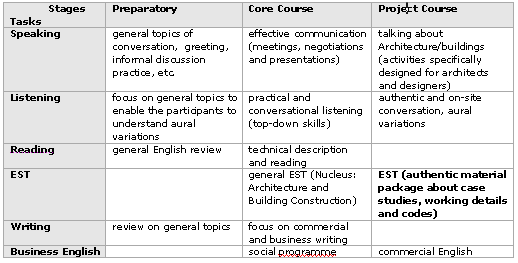
Appendix 2. EST Course Syllabus
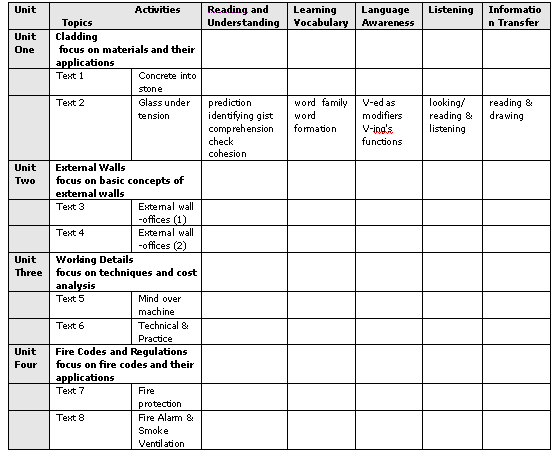
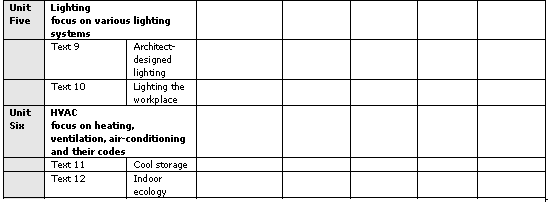
Appendix 3. Text: Glass under Tension
Glass under Tension
Hardware traditionally machined for racing yachts is now being architecturally applied to create curtain walls that are more transparent than conventional cladding. American architects are beginning to take advantage of slim, stainless steel rods and fittings to create tensile wall systems that can support more with less.
Such technology was first considered by Buckminster Fuller in the late 1940s and
has been applied to many structures in Europe, especially in Britain and in France,
over the past decade. One of the most significant glass-
Reducing structure
Tensile systems reduce the size of structural members by replacing the lateral load-
While both tension and compressive forces are resisted by a single member in conventional structures, tension members are designed only to resist tensile loading from a specific direction and are useless if thrown into compression. Wind forces on an exterior glazed wall, usually compensated for by a structural member located perpendicular to the wall, can be withstood by a pair of tension rods separated by compressive struts, one resisting inward forces and the other resisting outward forces. Tensile structures are usually built from rods, rather than cables, because rods are stronger and smaller in diameter. These rods consist of steel with a breaking strength of 200,000 pounds per square inch, about four times the strength of ordinary steel.
Advances in manufacturing
Tensile technology has also been advanced by the development of the computer tools
needed to calculate the dynamic behavior of tensile structures, enabling engineers
to correctly size the members. Nonlinear systems are especially challenging to design,
because the tension elements are left slack and are tensioned only as needed to resist
building movement. Tensile structural systems have also grown more sophisticated
with the advent of computerized numerical-
To achieve near total transparency, glass can be attached to the tensile system without mullions. In other applications, the glass is held in standard mullions or narrow channels that are fastened to structural members. Alternately, the glazing can be adhered to the tensile rods with structural silicone.
Tensile cladding systems have been slow to catch on in the U.S. until now because American architects have not been well acquainted with the technology. In addition, the high degree of customization required of many glazed tension structures has meant a high price. But projects such as the Medical Center Library at Vanderbilt University, with its hybrid tensile system, and Pilkington and Tripyramid's standardized systems promise to break down cost barriers. Such developments will enable more architects to experiment with the lightness, delicacy, and transparency inherent in tensile cladding systems.
Virginia Kent Dorris From Architecture Journal
Appendix 4. Pre-
Pre-
1. Some Things to Think About
Working with Glass: How often have you worked with glass as a cladding material? Be ready to share your experiences with the rest of the group. Think about some of the joys and also difficulties of working with glass in this way. Was its use successful or not? If you have not worked with glass, think about why not.
2. Pre-
You are going to read a passage called ‘Glass under Tension’. Work with a partner to answer the following:
1). List some of the words (e.g. materials, properties, etc.) that you expect to find in the passage?
2). From your own work experiences and knowledge, which advantages of tensile structure are likely to be mentioned?
Teacher’s Notes
1. Students are required to do individual work, but they can discuss with partners. The previous work experiences are main resources of this task.
2. Students go on with discussion on Task 1, but should concentrate on vocabulary and advantages concerned with tensile structure systems.
Appendix 5. During-
5. Comprehension Check
Now read the text carefully. Try to get as many facts and details as possible.
1). What types of attachment used in a building are mentioned in the text?
2). How have computers helped engineers and architects in their design of tensile structures?
3). What two broad categories of tensile system are mentioned in the text?
4). What is the main advantage (as mentioned in the first paragraph) of tensile wall systems?
5). What specific properties or qualities are mentioned in the final paragraph?
6). Why are tensile structures usually built from rods and not cables?
7). List the buildings and architects mentioned in the text?

8). List some specific differences between conventional curtain wall systems and tensile systems by completing the table below:

9). What is the main difference between conventional and tensile curtain wall systems?
_________________________________________________________
10). An example is given in the text of how particular forces can be compensated for in the design of buildings. Fill in the table below with the necessary information from the text:

6. Cohesion
Skim the paragraphs from the text again. Decide what the circled words refer to and write down your answers:
1). More what? Less what?
____________________________________________
2). What technology does this refer to?
____________________________________________
3). Other what?
____________________________________________
4). What can be withstood? ____________________________________________
5). The other what?
____________________________________________
6). What enables engineers to correctly size the embers?
____________________________________________
7). What technology? ____________________________________________
8). Which developments?
____________________________________________
Now compare and discuss your answers with a partner.
Learning Vocabulary
When reading the text, you have met some unfamiliar words. Do not look up all of them from dictionaries. It will interrupt your comprehension. Try to identify and analyse them from their formation, classification or context clues.
7. Word Formation
Identify and understand the meaning of the 12 words listed below from their word formation. Classify them from their formation and put them under the proper headings. Work with a partner to discuss and explain the meaning or use of the words.
e.g. add ® addition 'addition' is the noun form of 'add' because suffix
'-
whiteboard ® white + board 'whiteboard' is a compound noun
consisting of an adjective, 'white' and a noun, 'board', meaning a
white board.
oil (n.) ® oil (v.) 'oil' used as a verb is converted from the noun
form of 'oil', meaning 'put oil on or into'.

1). hardware (line 1)
__________________________________________________
2). stainless (line 6) __________________________________________________
3). backer (line 29) ___________________________________________________
4). size (line 52) ___________________________________________________
5). nonlinear (line 52)
___________________________________________________
6). numerical (line 58)
___________________________________________________
7). facilitates (line 59) ___________________________________________________
8). customization (line 74)
___________________________________________________
9). compressive (line 32)
___________________________________________________
10). compression (line 37)
___________________________________________________
11). tension (line 32) ___________________________________________________
12). tensile (line 35) ___________________________________________________
8. Word Families
Work with a partner. Scan the text again and write down all the words connected with...

Language Awareness
9. Use of V-
1). Look at V-
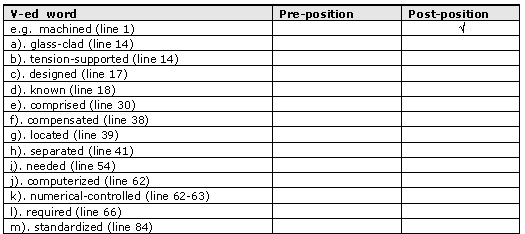
2). Can you, in each case, write a longer phrase or sentence which captures the meanings.
e.g. glass-
a). tension-
b). designed (line 17)___________________________________________
c). known (line 18)_____________________________________________
d). comprised (line 30)__________________________________________
e). compensated (line 38)________________________________________
f). located (line 39)_____________________________________________
g). separated (line 41)___________________________________________
h). needed (line 54)_____________________________________________
i). computerized (line 62)________________________________________
j). numerical-
k). required (line 66)____________________________________________
l). standardized (line 84)________________________________________
10. Use of V-
From the text, you may find many V-
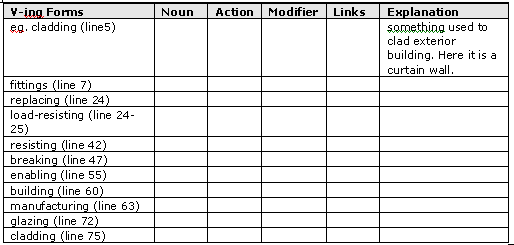
Appendix 6. Post-
Listening
11. Browsing and Listening
1). Look at the following photos and drawings of Vanderbilt University Medical Center Library. Identify and discuss what they show.
2). You are going to listen to a conversation between an architect and a journalist talking about using a tensile structural system in the curtain wall construction. Read the elements chosen in the table before listening. Then complete the table with information from the conversation.
VANDERBILT UNIVERSITY MEDICAL CENTER LIBRARY

3). Now listen again and complete the sentences:
A). The area of the library is _________.
a). 18,600-
b). 86,000-
c). 80,600-
B). The _________ wall of transparent glass is insulated.
C). The curtain wall glass is _______ inch thick.
a). 1
b). 3/8
c). 49
D). The vertical trusses are spaced ________ feet apart.
a). 49
b). 40
c). 14
E). The curtain wall will be completed __________.
Information Transfer
12. Reading and Drawing
1). Reading:
The following text is about the Commonwealth Edison Transmission/Distribution Center. Read the text carefully and underline the words which give information about the building's facade.
2). Drawing:
The text provides a description of the west elevation of the building. Try and draw this elevation of the Commonwealth Edison building by using the information in the text. You may have to draw the elevation in stages: the window wall first, then the bays, columns and finally the truss network. Draw as much detailed as possible. Compare your drawing with that of others, and make any changes you feel are necessary.
3). Describing:
In a small group, describe your drawing in your own words.
Appendix 7. Teachers' Notes
Aims:
These in turn require the architects and engineers to be able to:
· To present and practise expressions describing a tensile structural system and its application in specific buildings.
· To practise reading skills.
· To develop awareness of functions of grammatical items and lexis.
· To practise listening skills with literal and visual aids.
· To practise information transfer with reading comprehension.
· The text presents content, language and visual input. Tasks include skills and functions.
Input:
Content
· an authentic article from an Architecture journal talking about the new technique of a tensile structure system and glass used as curtain wall material.
· a specific application of the techniques to Vanderbilt University Medical Center Library.
· another application to the Commonwealth Edison Transmission/Distribution Center.
Language
· lexis: subject-
· word formation: affixes and compound words
· word family: words of material, forces and loads, glass, components and parts
· V-
· spoken forms: conversational features of colloquial, hesitation, rephrasing, self-
Pictures
· photos of North Wall of Vanderbilt University Medical Center Library
· photos of design details
· photos of vertical truss
· axonometric drawing
Tasks:
Skills
· reading: -
· speaking: discussing, answering questions, giving comments, presenting, explaining,
· describing
· listening: a tape-
· writing: writing down answers, filling tables and blanks, writing comments
Functions
· identifying
· listing
· hypothesizing/predicting
· visualizing
· understanding
Teaching Methods, Procedures and Suggested Answers:
This text is suggested to be implemented for 4 hours:
1st hour: Task 1-
2nd hour: Task 6-
3rd hour: Task 10-
4th hour: Task 12
Scripta Manent Vol. 3 (2)
» Contents
Pedagogical Application of Specialized Corpora in ESP Teaching: the case of the UVaSTECorpus
» Y. Chen
Material Production for an EST Course: Coursebook Design for the English Training Programme for Architects and Civil Engineers
» Jenček
Angleško-
Recenzija
Previous Volumes
© 2005-